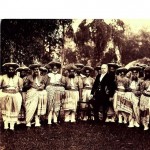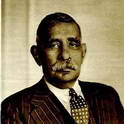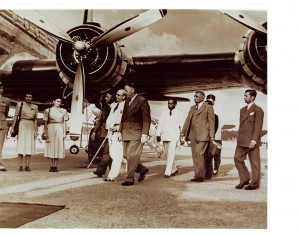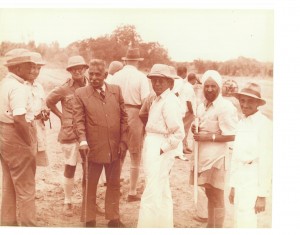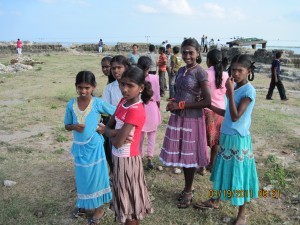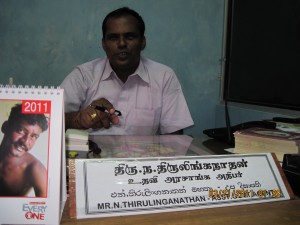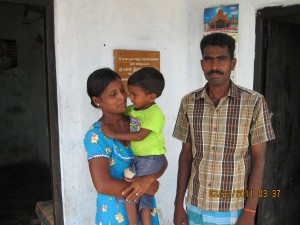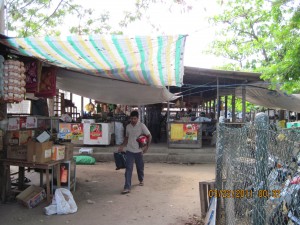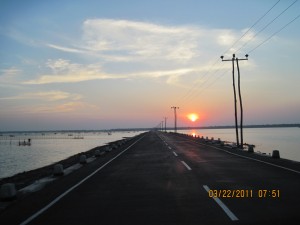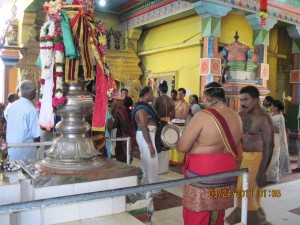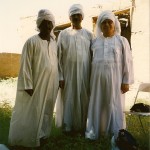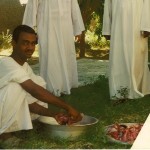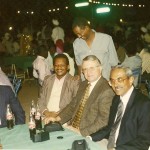Repression of minorities
Whenever the international media refers to Sri Lanka, a developing country in the Indian Ocean that usually gets little exposure for its creditable achievements in human development, they conclude a basically critical piece with the standard ending, “Tamils are discriminated against in Sri Lanka” or, in a slightly more generous mood, “Tamils claim they are discriminated against in Sri Lanka”. If this needs elaboration to bring in the background, it may add that “there has been systematic discrimination against Tamils by the Sinhalese dominated government of Sri Lanka in employment and education since the Sinhala Only Act of 1956, ..” etc. So 1956 is the date of The Original Sin and the Act was the legislation pushed through in the national parliament to make Sinhala the sole Official Language of the country. From then on, one can be assured, the Sinhala dominated country went on an aggressive path of discrimination and marginalization of the Tamil minority. This, presumably, also justifies the use of mass terror by the LTTE on the entire civilian population and leaders of all communities using explosives concealed in public places, suicide bombings and indiscriminate attacks on Sinhala and Muslim places of congregation and armed insurrection to occupy and govern national territory.
Gen. Ashok Mehta, giving a presentation at the prestigious Indian Centre for Land Warfare Studies, gives a more comprehensive list that covers more issues :
“Four watershed events spurred the ethnic conflict in Sri Lanka – the Sinhala Only Act of 1956, the Republican Constitution of 1972, the Parliamentary elections of 1977 and the 1983 ethnic riots. The killing of 13 Sri Lankan Army (SLA) soldiers by the Liberation Tigers of Tamil Eelam on 23 July 1983 marked the initiation of armed hostilities …”
So it would appear that the majority Sri Lankan community, the Sinhala, out of bloody-mindedness, started targeting the minority Tamils without provocation to establish their total domination from 1956 onwards. No matter that the Ceylon Tamils were only 12% of the population and that the Muslims (7%) and the Indian Tamils (6%) did not join them and did not feel equally discriminated. There is also no mention that the Sri Lanka government had previously shown itself vulnerable to armed insurrection from 1971 to about 1978 when the Sinhala youth under the Marxist influenced Jatika Vimukthi Peramuna (JVP) waged war and at one point nearly overthrew the government. About 60,000 died in this very brutal conflict but international think tanks, NGOs, the UN and the so-called International Community (the Western Nations Only Community) have chosen to ignore this bloody conflict because it was by Sinhala youth. The JVP insurrection probably inspired LTTE leader Velupullai Prabhakaran and convinced him the Sri Lankan government could be overthrown because of its military weaknesses at the time.
Gen. Ashok Mehta and other international commentators now choose to forget that the armed LTTE insurrection was originally sponsored by the Government of India under Prime Minister Indira Gandhi. Indira Gandhi, angered by the tilt of the J.R. Jayawardena government of Sri Lanka after 1979 towards friendship with the USA and abandonment of former socialist policies and the Non-Aligned Movement, armed and trained Prabhakaran and his fellows and even prepared twice to impose Indian authority through military invasion, plans that were foiled by secret CIA interventions. Detailed accounts of these were contained in the India Today news magazine of that period. India sustained the LTTE for decades with facilities for LTTE arms factories, training centres and hospitals in South India. Open support of the LTTE by India only ended when, through an ironical act of fateful retribution, the LTTE monster created by her assassinated Indian Prime Minister Rajiv Gandhi, Indira’s own son, in 1991. Indira Gandhi herself was assassinated by her Sikh bodyguard in 1984.
Historical background to Sinhala Tamil relations
Racial discrimination is historically based on ideas of racial superiority. So Europeans, since the 16th century, conquered Asians, Africans and South Americans and justified this on the basis of their being a superior race of people. In the British Empire of yore, “Where the Sun never sets”, the socially lowest White European was held above the highest native chieftain or wealthy Indian maharajah. Even the wealthiest natives were barred from “Europeans Only” social clubs till a few decades ago. The enslavement of Africans and the continuation of their subordinate status in the USA were justified on the same grounds of racial superiority. But never in the 2,600 year history of Sri Lanka did the Sinhala or Tamil people consider themselves racially superior to the other community.
The Sinhala and Tamil people are blood relations as DNA tests indicate that the genetic marker of most Sinhala people is the same as that of the majority of South Indians. The Mahavamsa, the great 4th century A.D. chronicle of the Sinhala people, states that Prince Vijaya’s (the first Sinhala king, around 600 B.C.) followers went to Madurai in South India to obtain from the King of Pandu a royal wife for him and wives for his 700 retainers . The Salagama, Karava and Durawa people of southwest coastal Sri Lanka mainly migrated in the Portuguese period in the 16th century and even up to the 18th century from South India but became Sinhala simply by declaring themselves as Sinhala Budhhists.
The Sinhala royal families have for two thousand years been associated with the royal families of Madurai in South India with whom they constantly inter-married, as their was no kshastriya caste in Sri Lanka. Of the three great Sinhala kings of the Polonnaruwa period who ruled a united Lanka, Parakrama Bahu the Great was three quarters Pandyan and his successor, Nissanka Malla, was a Prince of Kalinga. From 1739 to 1815, when Sri Lanka lost her independence, the Sinhala Kandyan Kingdom gave the monarchy to the Nayakkar royal family of Madurai as the last Sinhala king, Narendrasimha, had no heir.
Nowhere in the history of the world has there been such an open society as ancient Sinhala society which generously accepted people of other races and religions into their fold and made them their own. It was this trusting spirit that persuaded the Kandyan chiefs to voluntarily offer the monarchy of Ceylon to the British monarch after quarrelling with their own king, Sri Wickrama Rajasinha, in 1815. They did not realise that the British were without honour and that the Kandyan Convention they signed would be discarded within 3 years by the British after consolidating their power to make their country a vassal state.
Development of Communalism
Communalism in Sri Lanka is a product of British rule. In 1833 when unofficial representatives were first nominated to the Legislative Council under the Governor’s powers, the representation was both unequal and unrepresentative: Sinhala (72% of population) – 1; Ceylon Tamil (12%) – 1, Indian Tamil (8%) – none; Muslims (7%) – none; Burghers (1%) -1: Europeans (0.2%) – 3. This ratio of nominated communal representation between Sinhala and Tamil varied later from 1:2 and again 2:3. When the principle of limited franchise was introduced in 1912 there were 3 Sinhala and 3 Ceylon Tamils. In 1921, the limited franchise was based on election to provincial electorates and then the number of Sinhala elected quadrupled while the Ceylon Tamil number remained the same. The Ceylon Tamil representatives protested and the British government in 1923 decreed a ratio of 2 Sinhala for every 1 Ceylon Tamil representative. Sri Lankan politics was henceforth based on race. Since that time, with every advance in constitutional status, the Sinhala and Tamil representatives displayed some element of communal politics. Under the Donoughmore Constitution of 1931 which instituted universal adult franchise for the election of 50 members of the State Council on an electoral basis, the representation by communities in 1945 was as follows: Sinhala 39 (78% of total seats), Ceylon Tamil 8 (16%), Indian Tamil 2 (4%), Muslim 1 (2%). Even here the Ceylon Tamils and the Sinhala were over-represented while Indian Tamils and Muslims were under-represented.
It is undisputed that the Ceylon Tamil minority dominated Sri Lanka during the colonial era in the professions, public service, business and political power in relation to their numbers. The British distrusted the Sinhala for a long time as they had risen in rebellion against injustices under British rule in 1818 and 1848. The Ceylon Tamils on the other hand, displayed loyalty to British rule. Better missionary educational services in the north gave Ceylon Tamils an advantage in entering the public services and the professions and they used this for the advantage of their own community. The economic advance of a minority community, like the Ceylon Tamils in Sri Lanka, is not a bad feature. It can be a factor for progress if it serves as a guide to other communities and works for national development. It was something to be welcomed. But the Ceylon Tamils used this advantage to marginalise the other communities, as we shall see.
The All-Ceylon Tamil Congress Scheme
In September 1944 the Council of Ministers of the State Council, at the request of the British Colonial Office, had set forth their proposals for a new constitution based on self-government through Ceylon Sessional Paper XIV. But when the British government by-passed this and appointed the Soulbury Commission in July 1944 for the same purpose, the Council of Ministers withdrew their proposals and refused to cooperate with the new commission. So the only comprehensive proposal was by the All-Ceylon Tamil Congress headed by G.G. Ponnambalam, though 80 persons or groups met the commissioners with oral and written proposals or opinions.
The All-Ceylon Tamil Congress, led by G.G. Ponnambalam, made a detailed proposal to the Soulbury Commission on a scheme of “balanced representation” which stands as a landmark in aggressive communal politics. The information given here is from the original report by the Soulbury Commission named “Ceylon – Report of the Commission on Constitutional Reform, Presented to the Secretary of State for the Colonies, 1945”, marked “Confidential” and published by His Majesty’s Stationery Office, London.
The All-Ceylon Tamil Congress Scheme, as the Soulbury Report calls it, was the high-water mark of Tamil communal aspirations up to that date. Its assumption was that the majority Sinhala community should be disempowered in future by making them a political minority in order to forestall their potential to discriminate against minorities. Allegations of discrimination by the Sinhala that were presented by them to the Commissioners were rejected by the report as unsubstantiated and false.
The scheme was as follows:
1. The legislature should have 100 electorates for a 100 seat assembly based on elections.
2. 50 seats would be reserved for minorities.
3. Of these 50 minority seats, 25 would be reserved for Tamils and the other 25 would be open to all minorities.
4. The other 50 seats would be open all communities, ie. They would not be reserved for the Sinhala.
When it was pointed out that this was deliberately intended to make the Sinhala majority a minority, the Tamil Congress amended this to state that 50 seats could be reserved for the Sinhala. The proposal advanced numerous dubious assertions to justify their extraordinary demands. But as the Soulbury Commission points out, the intention was really to control executive power with the demand that “The Governor should choose the Council of Ministers in consultation with leaders of various communities in the Legislature, but that it should be provided by Statute that less than half of the members of the Council of Ministers should be chosen from any one community” . The Soulbury Report rejected these demands and concluded thus:
“We think that any attempt by artificial means to convert a majority into a minority is not only inequitable, but doomed to failure. ”
It was clear that the Tamil minority that had achieved a dominant position in the professions, in business and the public service, was bent on expanding this power to marginalise the majority Sinhala for ever. This was something that even the powerful South Indian Chola invaders had failed to do in ancient times. This is the real Original Sin in Ceylon’s communal politics.
According to the report, the population ratio at the time in Ceylon was as follows:
1. Low Country Sinhala 2,596,479 (42.8%)
2. Kandyan Sinhala 1,467,429 (24.2%)
3. Ceylon Tamils 697,032 (11.5%)
4. Indian Tamils 812,113 (13.4%)
5. Ceylon Moors 339,456 (5.6%)
6. Indian Moors 44,499 (0.7%)
7. Europeans 10,938 (0.2%)
8. Burghers/Eurasians 39,666 (0.7%)
9. Malays 18,058 (0.3%)
10. Veddahs 6,078 (0.1%)
11. Others 29,588 (0.5%)
Total 6,061,336 (100%)
Post Independence
Despite the outrageous efforts of the All-Ceylon Tamil Congress to marginalise the Sinhala, D.S. Senanayake, the first Prime Minister of independent Ceylon, offered the All-Ceylon Tamil Congress two senior cabinet portfolios. G.G. Ponnambalam took the sensitive post of Minister of Industry and proceeded to build large state manufacturing enterprises in the Tamil dominated areas: The Paranthan Chemicals Corporation, the Valachennai Paper Corporation and the Cement Corporation factories in Kankasanthurai and Puttalam. Yet he lost the support of the majority of Ceylon Tamils who voted at the next elections overwhelmingly for the Federal Party that demanded a separate federal state for the Ceylon Tamils.
Despite the efforts of D.S. Senanayake to accommodate an intransigent Tamil political leadership, his successors could not bridle the frustration of the Sinhala majority, particularly the rural Sinhala majority, who saw continuing plans by the Tamils to marginalise them. This led to the 1956 Bandaranaike government and the Sinhala Only Act and the aggressive communal stance of a section of the Sinhala population, the hitherto “Silent Majority”.
Concept of Original Sin
The concept of Original Sin exists only with the Judeo-Christian-Islamic religions. It does not exist in the traditional South Asian religions: Hinduism, Buddhism and Jainism. In the South Asian beliefs, Good and Evil are two sides of the same coin, and Man must use his intellect and perform meritorious deeds to be reincarnated into a better life in the next birth. The doctrine of Karma decrees that no amount of pleading with Gods can change one’s fate. In Hinduism, people may constantly ask favours of gods for their personal problems but these gods cannot change a person’s Karma. The Christian priest addresses his congregation as “Sinners” and calls upon them to repent and ask forgiveness from God. The Buddhist monk addresses his audience as pinwathuni or “people who do meritorious deeds” and explains to them that the path of the Dharma and righteous behaviour is the only path to betterment.
Neo-colonialism is active around the world dictating to their former colonies in Asia, Africa and South America and continuing their age-old strategy of creating disharmony among communities to weaken these states. Now that the economies of the West are in decline and the Asian economies are on the rise, they are becoming targets of malicious propaganda. Sri Lankans need not fall into this trap. Terrorism that destroyed and maimed tens of thousands in Sri Lanka is over, and since the legislation which was the basis of discrimination like the Sinhala Only Act and others have been revoked, the people of that country should cease to harp on Original Sin which is alien to their culture and religions and seek to build a harmonious society. Sri Lanka has the highest Quality of Life indices in South Asia and is the only country with the real potential in the region to become a developed country soon. It should not be led astray by those who stole their freedom in the past.
Kenneth Abeywickrama
20 July 2011.
Copyrights reserved. This article may be copied in part or whole with the permission of the author.

